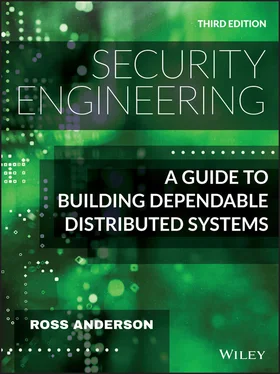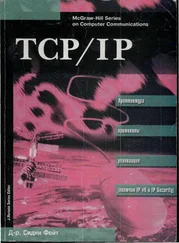One of the most pervasive and persistent errors has been forcing users to change passwords regularly. When I first came across enforced monthly password changes in the 1980s, I observed that it led people to choose passwords such as ‘julia03’ for March, ‘julia04’ for April, and so on, and said as much in the first (2001) edition of this book ( chapter 3, page 48). However, in 2003, Bill Burr of NIST wrote password guidelines recommending regular update [1098]. This was adopted by the Big Four auditors, who pushed it out to all their audit clients 3. Meanwhile, security usability researchers conducted survey after survey showing that monthly change was suboptimal. The first systematic study by Yinqian Zhang, Fabian Monrose and Mike Reiter of the password transformation techniques users invented showed that in a system with forced expiration, over 40% of passwords could be guessed from previous ones, that forced change didn't do much to help people who chose weak passwords, and that the effort of regular password choice may also have diminished password quality [2073]. Finally a survey was written by usability guru Lorrie Cranor while she was Chief Technologist at the FTC [492], and backed up by an academic study [1507]. In 2017, NIST recanted; they now recommend long passphrases that are only changed on compromise 4. Other governments' agencies such as Britain's GCHQ followed, and Microsoft finally announced the end of password-expiration policies in Windows 10 from April 2019. However, many firms are caught by the PCI standards set by the credit-card issuers, which haven't caught up and still dictate three-monthly changes; another problem is that the auditors dictate compliance to many companies, and will no doubt take time to catch up.
The current fashion, in 2020, is to invite users to select passphrases of three or more random dictionary words. This was promoted by a famous xkcd cartoon which suggested ‘correct horse battery staple’ as a password. Empirical research, however, shows that real users select multi-word passphrases with much less entropy than they'd get if they really did select at random from a dictionary; they tend to go for common noun bigrams, and moving to three or four words brings rapidly diminishing returns [297]. The Electronic Frontier Foundation now promotes using dice to pick words; they have a list of 7,776 words (  , so five dice rolls to pick a word) and note that a six-word phrase has 77 bits of entropy and is memorable [291].
, so five dice rolls to pick a word) and note that a six-word phrase has 77 bits of entropy and is memorable [291].
3.4.4.4 Operational failures
The most pervasive operational error is failing to reset default passwords. This has been a chronic problem since the early dial access systems in the 1980s attracted attention from mischievous schoolkids. A particularly bad example is where systems have default passwords that can't be changed, checked by software that can't be patched. We see ever more such devices in the Internet of Things; they remain vulnerable for their operational lives. The Mirai botnets have emerged to recruit and exploit them, as I described in Chapter 2.
Passwords in plain sight are another long-running problem, whether on sticky notes or some electronic equivalent. A famous early case was R v Gold and Schifreen, where two young hackers saw a phone number for the development version of Prestel, an early public email service run by British Telecom, in a note stuck on a terminal at an exhibition. They dialed in later, and found the welcome screen had a maintenance password displayed on it. They tried this on the live system too, and it worked! They proceeded to hack into the Duke of Edinburgh's electronic mail account, and sent mail ‘from’ him to someone they didn't like, announcing the award of a knighthood. This heinous crime so shocked the establishment that when prosecutors failed to persuade the courts to convict the young men, Britain's parliament passed its first Computer Misuse Act.
A third operational issue is asking for passwords when they're not really needed, or wanted for dishonest reasons, as I discussed at the start of this section. Most of the passwords you're forced to set up on websites are there for marketing reasons – to get your email address or give you the feeling of belonging to a ‘club’ [295]. So it's perfectly rational for users who never plan to visit that site again to express their exasperation by entering ‘123456’ or even ruder words in the password field.
A fourth is atrocious password management systems: some don't encrypt passwords at all, and there are reports from time to time of enterprising hackers smuggling back doors into password management libraries [429].
But perhaps the biggest operational issue is vulnerability to social-engineering attacks.
3.4.4.5 Social-engineering attacks
Careful organisations communicate security context in various ways to help staff avoid making mistakes. The NSA, for example, had different colored internal and external telephones, and when an external phone in a room is off-hook, classified material can't even be discussed in the room – let alone on the phone.
Yet while many banks and other businesses maintain some internal security context, they often train their customers to act in unsafe ways. Because of pervasive phishing, it's not prudent to try to log on to your bank by clicking on a link in an email, so you should always use a browser bookmark or type in the URL by hand. Yet bank marketing departments send out lots of emails containing clickable links. Indeed much of the marketing industry is devoted to getting people to click on links. Many email clients – including Apple's, Microsoft's, and Google's – make plaintext URLs clickable, so their users may never see a URL that isn't. Bank customers are well trained to do the wrong thing.
A prudent customer should also be cautious if a web service directs them somewhere else – yet bank systems use all sorts of strange URLs for their services. A spam from the Bank of America directed UK customers to mynewcard.comand got the certificate wrong (it was for mynewcard.bankofamerica.com). There are many more examples of major banks training their customers to practice unsafe computing – by disregarding domain names, ignoring certificate warnings, and merrily clicking links [582]. As a result, even security experts have difficulty telling bank spam from phish [445].
It's not prudent to give out security information over the phone to unidentified callers – yet we all get phoned by bank staff who demand security information. Banks also call us on our mobiles now and expect us to give out security information to a whole train carriage of strangers, rather than letting us text a response. (I've had a card blocked because a bank security team phoned me while I was driving; it would have been against the law to deal with the call other than in hands-free mode, and there was nowhere safe to stop.) It's also not prudent to put a bank card PIN into any device other than an ATM or a PIN entry device (PED) in a store; and Citibank even asks customers to disregard and report emails that ask for personal information, including PIN and account details. So what happened? You guessed it – it sent its Australian customers an email asking customers ‘as part of a security upgrade’ to log on to its website and authenticate themselves using a card number and an ATM PIN [1089]. And in one 2005 case, the Halifax sent a spam to the mother of a student of ours who contacted the bank's security department, which told her it was a phish. The student then contacted the ISP to report abuse, and found that the URL and the service were genuine [1243]. The Halifax disappeared during the crash of 2008, and given that their own security department couldn't tell spam from phish, perhaps that was justice (though it cost us taxpayers a shedload of money).
Читать дальше

 , so five dice rolls to pick a word) and note that a six-word phrase has 77 bits of entropy and is memorable [291].
, so five dice rolls to pick a word) and note that a six-word phrase has 77 bits of entropy and is memorable [291].









